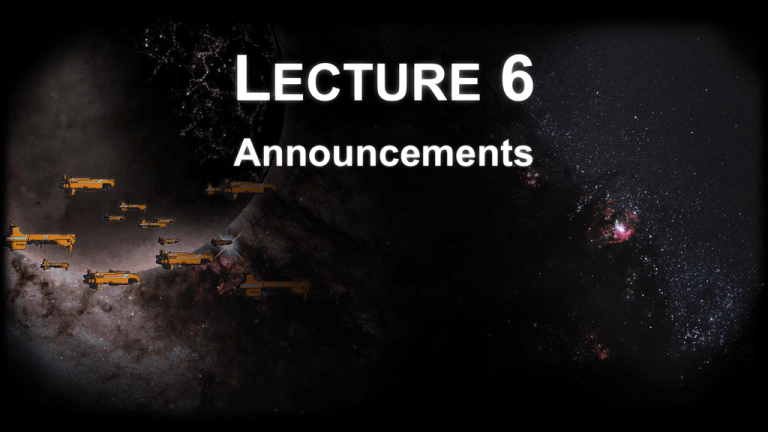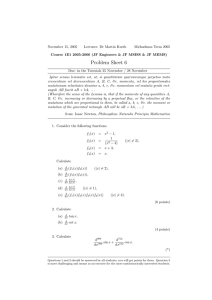L 6 ECTURE Announcements
advertisement

LECTURE 6
Announcements
Tou II Feedback
• Handins look varied and
fun!
• Write a Range or Interval
class
– Makes math code easier to:
• read
• write
• modify
– Makes M I easier to build
on top of Tou
Mid-Semester Feedback
• We only have 3 responses so far
• By doing the surveys you will:
– Make the class more enjoyable for future students
– Get to decide what advanced topics we cover first
• Please fill out both surveys!
M: Your last project (kinda)
• Platformer game
– 3 weeks
– Physics
– More physics
– Externalizing game
logic
Announcements
QUESTIONS?
LECTURE 6
Physics I
Physics I
INTEGRATION
Velocity
2.5
• Rate at which position
changes
• Just increment pos?
– pos = pos + vel
• Works fine with constant
frame rate…
• But frame rates vary
• So always use time
– pos = pos + vel*time
position
– 𝑣 = ∆𝑥/𝑡
2
1.5
1
0.5
0
0
2
4
time
Acceleration
• The rate at which
velocity changes
– 𝑎 = ∆𝑣/𝑡
• Useful for gravity,
springs, wind…
• vel = vel + acc*time
Which order to update?
Position first (Euler)
• pos = pos + vel*time
• vel = vel + acc*time
Velocity first (“Symplectic Euler”)
•
•
vel = vel + acc*time
pos = pos + vel*time
Which order to update?
Position first (Euler)
• pos = pos + vel*time
• vel = vel + acc*time
Velocity first (“Symplectic Euler”)
•
•
•
vel = vel + acc*time
pos = pos + vel*time
stabler than Euler; use this
Physics I
COLLISION RESPONSE
Collision response
• You know how to detect
whether 2 objects collide
• How do we make objects
respond in a physically
believable way?
• General strategy:
1. Move objects out of
collision
2. Change their velocities
Moving out of collision
• Many ways to move the
ball out of the wall
• We want the minimum
• “Minimum translation
vector” (MTV)
• Same as overlap
• For now, assume we can
find MTV
Changing velocity for collision
• Just reverse the object’s
velocity?
𝑣𝑒𝑙 = −𝑣𝑒𝑙
• Reverse the y component?
𝑣𝑒𝑙𝑦 = −𝑣𝑒𝑙𝑦
• Reverse the perpendicular
component?
– What if 2 moving objects
collide?
2-moving-object collisions
• Reverse both velocities?
• Doesn’t always work
• Apply equal and
opposite forces
• An instantaneous force is
called an impulse
Units
Without mass
• position
m
With mass
• (no equivalent)
– 𝑥
• velocity
m/s
– 𝑣 = ∆𝑥/𝑡
• acceleration m/s2
– 𝑎 = ∆𝑣/𝑡
• momentum
kg m/s
– 𝑝=𝑚𝑣
• force
kg m/s2
– 𝐹 = ∆𝑝/𝑡
• impulse
– ∆𝑝
kg m/s
Implementing force and impulse
•
•
•
•
•
applyForce(…) accumulates force
applyImpulse(…) accumulates impulse
onTick(…) applies force and impulse,
clearing them for next frame
applyForce(…) and applyImpulse(…)
only take effect on next onTick(…)
“Static” (immovable) objects can override
applyForce (…) and applyImpulse (…)
and make them no-ops
class PhysicsEntity {
float mass;
Vec2f pos, vel;
Vec2f impulse, force;
void applyForce(Vec2f f) {
force += f;
}
void applyImpulse(Vec2f p) {
impulse += p;
}
void onTick(float t) {
vel += t*force/mass + impulse/mass;
pos += t*vel;
force = impulse = 0;
}
}
Impulse collision response
• Translate objects out of
collision
– Each by MTV/2
– Or proportional to velocity in
direction of MTV
• Apply some impulse
proportional to MTV to each
object
– How much?
– This week: guess/hack
– Next week: more realistic
Collision callbacks
•
•
•
•
•
•
Pass in other Entity
class PhysicsEntity {
Separate Collision info
boolean
void onCollide(PhysicsEntity);
onCollide(Collision);
void onCollide(Collision);
object (really a struct)
}
Pass in the MTV
Maybe pass in which
shapes collided
class Collision {
– Enemies with weak points
final PhysicsEntity other;
Maybe allow callback to
prevent solid collision
final Vec2f mtv;
response
final Shape thisShape;
– One-way platforms
final Shape otherShape;
Double dispatch is your
friend!
}
Can we do better?
abstract class PhysicsEntity<T extends PhysicsEntity<T>> {
boolean onCollide(Collision<T> collision);
}
abstract class PhysicsWorld<T extends PhysicsEntity<T>> {
List<T> physEntities;
@Override void onTick(float seconds) {
for (T entity1, entity2: physEntities) {
// check if entity1 collides entity2, construct a collision object,
// and pass that object to both entities } }
}
class Collision<T extends PhysicsEntity<T>> {
final T other; final Vec2f mtv; final Shape thisShape; final Shape otherShape;
}
// MEntity extends PhysicsEntity<MEntity>, and MWorld extends PhysicsWorld<MEntity> done, with all callbacks generated in the engine!
Physics I
MINIMUM TRANSLATION VECTOR
MTV in one dimension
• In 1D, convex shapes are
line segments (intervals)
• These have a 1D MTV
– Similar to overlap
– But it has a sign
• Write a method that
computes this
• Use it to find shapes’ MTV
Computing MTV
1. For each (normalized!) axis, find 1D MTV of
shapes’ projections
2. Find the axis giving minimum 1D MTV
3. 2D MTV is 1D MTV times that (normalized)
axis
MTV interactive demo
• Same as last week
• Arrows are potential MTVs
for box against triangle
• Purple arrows are the
actual MTV
• SAT guarantees that MTV
is on a separating axis
Computing intervals’ MTV
Float intervalMTV(Interval a, Interval b)
Float aRight = b.max - a.min
Float aLeft = a.max - b.min
if aLeft < 0 || aRight < 0
return null
if aRight < aLeft
return aRight
else
return -aLeft
Computing polygons’ MTV
Vec shapeMTV(Shape a, Shape b)
Float minMagnitude = +infinity
Vec mtv = null
for Vec axis in allAxes
Float mtv1d = intervalMTV(a.proj(axis),
b.proj(axis))
if mtv1d is null
return null
if abs(mtv1d) < minMagnitude
minMagnitude = abs(mtv1d)
mtv = axis.smult(mtv1d)
return mtv
Computing circles’ MTV
• Circle vs Circle
– Compare dist(center1, center2) and sum of radii
– MTV is parallel to line connecting centers
• Circle vs Poly
– Use the same set of axes you did last week:
• Poly’s edge normals
• Vector from circle center to closest vertex
Computing circles’ MTV (ctd)
• Circle vs Box
– If Box contains circle center
• Use Box’s axes
– Otherwise
• Clamp circle center to Box
• Compare dist(center, clampedPoint) and radius
• MTV is parallel to line connecting
Computing boxes’ MTV
• Easy but inefficient way:
– Box converts itself to a Poly
• Efficient way:
– Use (0, 1) and (1, 0) as the only 2 axes
MTV pitfalls
• Be careful with signs and argument order
– Especially when reversing args for double dispatch
• Can use asserts:
– MTV of shape A to move it out of shape B should
point from B to A
– assert dot(MTV, A.center – B.center) > 0
Physics I
QUESTIONS?
LECTURE 6
Tips for M I
Gravity
• On each tick, for each entity e,
e.applyForce(g.smult(e.mass))
• Static objects’ applyForce() does nothing
– Consider how collision with a static object differs
from collision with dynamic object
Player motion
• Set velocity while left or
right is held?
– Too sudden
– Can interact badly with
other physics
• Apply force while left or
right is held?
– Asteroids!
Goal velocity
set directly
from arrow keys
• Gradually set velocity to
• goalVelocity
goalVelocity
• By applying a force
• 𝐹 = 𝑘(𝑣𝑔𝑜𝑎𝑙 − 𝑣𝑐𝑢𝑟𝑟𝑒𝑛𝑡 )
Tips for M I
QUESTIONS?
Annotations
JAVA TIP OF THE WEEK
Pitfalls of inheritance
• What if you
Entity
• Change name?
• Change arg types?
• Might forget to change a
subclass (if not using
Eclipse’s refactor tools)
• Subclass’ method no
longer overrides
anything!
• How can we avoid this?
onTick(float)
onTick(long)
PhysicsEntity
onTick(float)
onTick(long)
Player
onTick(float)
onTick(long)
Enemy
onTick(float)
onTick(long)
Bullet
onTick(long)
The @Override annotation
• Whenever you override a
method, mark it @Override
• If superclass changes, you
get a compile error
• Eclipse can insert these for
you
public class Entity {
public void onTick(float t) {
// ...
}
}
public class Bullet extends PhysicsEntity {
@Override
public void onTick(long t) {
// ...
}
}
Bullet.java:2: method does not override or
implement a method from a supertype
Other standard annotations
• Annotations can mark:
–
–
–
–
–
classes
methods
fields
variables
parameters
• Can create your own…
– See Oracle’s tutorial if
you’re curious
• @Deprecated
– Alternative to removing a
method entirely
– Compile warning when
marked method is used
• @SuppressWarnings
– Tells the compiler not to
catch you when you fall
– Avoid if at all possible
– Typically an indication of a
larger problem
Annotations
QUESTIONS?
LECTURE 6
Final Project Overview
Overview
• Can be any 2D game
• You should work in groups!
• Each person is responsible for 10 “points” worth of
new engine features
– More members in a group means more engine features
– More details in the final project handout
Timeline
• 4 main parts:
– Week 1: Idea
– Week 2: Form groups
and get approved
– Week 3: Design
– Weeks 4-8: Code,
playtest, polish, present
Week 1: Idea (this week!)
• A ½ to 1 page document
• Describe basic gameplay idea
– How is your game fun?
– Why should someone want to help make it?
• Describe engine feature(s) you plan on implementing
• Give a 60-second “elevator pitch” of your game in class
• Everyone must give a pitch, even if you already know
your group and which project you’re working on
Week 2: Groups
• Form a group (or decide to work alone)
• Finalize game and engine features
• Each group must meet with the TA’s to present the
following:
– A more polished idea of the game
– Breakdown of member responsibilities for engine
Week 3: Design
•
•
•
•
•
Research new engine features
Design the engine and game
Exact breakdown of member responsibilities
Choose someone’s engine to use or integrate engines
For groups of 3 or more
– Explain how you will use version control
Weeks 4-8
• Week 4:
– Engine should be mostly done
– Game exists
• Week 5:
– Engine should be done
– Game is playable
– 5 playtests per member from people not in CS1971
Weeks 4-8
• Week 6:
– Game should be mostly done
– 5 more playtests per member from outsiders
• Week 7:
– Game should be done
– 5 playtests per member
– Powerpoint slideshow for postmortem presentation
Weeks 4-8
• Week 8:
– Polish up your game, bug fixes, etc
– Create an executable and put it in /contrib
– Make a video demo of your game from gameplay footage
• It is now December 20th
• And then you’re done!
Final Project Overview
QUESTIONS?
GAME DESIGN 5
CS1971 – 2012, 2013, 2014
(Past Final Projects)
Brief Summary
• Focuses on past video games developed by
students in:
– CS32
– CS1971
• What went right?
• What went wrong?
• Discuss final project ideas
Sunlab Games
• Fun for the first five
minutes…
• …Then you remember
you have other work to
do
Common Themes
• Overstretching
– More than what can be created in a 4 week time
period
• No polish
– Focused too much on content development
• NOTE: These are post-mortem summaries;
your post-mortems should be more in-depth
Reject Wars (2012)
• Networked platforming
shooter
• Java sockets and
Threads
• Similar to Super Smash
Bros.
Reject Wars – What went right?
• Networking
– Understood Java Sockets and Threads a lot better
• Basic gameplay – done!
• Character sprites
– Zach Davis! Lump Space Princess! Magikarp!
Reject Wars –What went wrong?
• Networking
– Serialized the game world…
– Scaling issues
• Environmental sprites
• Stage-based strategy didn’t work out
Prismatic (2013)
• 2D top down puzzle
game (Castle Crashers
theme)
• Based upon interacting
with light rays
• 20+ different entities to
interact with (enemies,
objects, etc…)
Prismatic– What went right?
• 4-man team – excellent division of labor
– Level editor, gameplay, UI, file system
• Good expectations
• Users have own profiles, can upload levels for
each other to play
Prismatic–What went wrong?
• Lack of playtesting
• Some, but not much, polish
• Not much else…
Galaxy Ferret (2013)
• Shoot ‘em up
inspired by Star Fox
• Player purchases
upgrades to make
their ship stronger
• Open structure –
player chooses
which levels to play
Galaxy Ferret – What went right?
• Well-polished gameplay with varied mechanics
– Barrel rolling, regenerating shields, different
weapon types, large enemy variety, fun bosses
• Consistent cartoony-space aesthetic
• Particles, particles, particles
• Built off of a strong Tou 2, so most of the core
was done from the start
Galaxy Ferret – What went wrong?
• Lots of little engine features implemented but
barely used
– Sound, parallax, cutscenes, screen transitions
• Open-world structure ended up not making
sense and was hard to balance
• Levels were hardcoded and slow to create
– Should have created some parsable file format
Demos!
• Prismatic
• Galaxy Ferret
• Constant Chaos
CS1971: Past Projects
QUESTIONS
Game Design 5
TIPS FOR FINAL
Coming up with a good idea
• All games start with an
idea
• Ideas are finicky – they
come on their own terms,
when they feel like it
• Be prepared to write
them down whenever
they come to you!
Developing an idea
• Once you have your initial idea, start defining crucial
details:
–
–
–
–
Genre?
Singleplayer or multiplayer?
Ideal team size?
Biggest risks?
• Come up with a simple prototype you can build quickly
– Minecraft example: only placing/removing blocks with just a few
distinct block types
– These will help you immediately find out if your idea is fun
What we don’t see…
•
•
•
•
•
•
•
Simulation (Roller Coaster Tycoon)
Strategy (Starcraft, Civilization)
Rhythm (Dance Dance Revolution)
Racing (Mario Kart)
Fighting (Street Fighter)
Horror (Clocktower)
Multiplayer co-op (Battletoads)
What we get A LOT of
•
•
•
•
Platformers
RPGs
Platformers
Platformers
Avoiding problems…
• Organize; know your abilities
• Be reliable to your teammates
• Settle on a coding convention
– Follow it!
• Take initiative
– There’s always that one guy who says: “Doesn’t matter to
me, I’ll do anything”
• FIX BUGS!!!
– Don’t put it off till later!
Making it better…
• Add juice!
– Screen shake, tweening, mouse effects
• Playtest, playtest, playtest
• Steal ideas from awesome games
– Even AAA Companies do this
Single Player vs. Multiplayer
Single player
• Easier to balance
• No networking
• Harder to keep the player
engaged
Multiplayer
• Other players essentially
become your content
• Increased bang for your
buck content-wise
• Networking can be tricky
to debug
TOU 2 PLAYTESTING!
Hooray!




